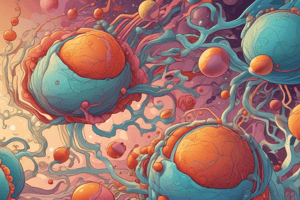Podcast
Questions and Answers
What is biochemistry?
What is biochemistry?
The study of the chemical processes that occur within and related to living organisms.
Which of the following is NOT a function of the plasma membrane?
Which of the following is NOT a function of the plasma membrane?
- Controls the movement of substances in and out of the cell
- Provides structural support (correct)
- Facilitates cell movement
- None of the above
What does the nucleus contain?
What does the nucleus contain?
DNA
The __________ is involved in energy production through cellular respiration.
The __________ is involved in energy production through cellular respiration.
Which organelle is responsible for protein synthesis?
Which organelle is responsible for protein synthesis?
Prokaryotic cells have membrane-bound organelles.
Prokaryotic cells have membrane-bound organelles.
Match the following cell components with their functions:
Match the following cell components with their functions:
What are the types of cells?
What are the types of cells?
The __________ produces ATP through cellular respiration.
The __________ produces ATP through cellular respiration.
Study Notes
Biochemistry: The Study of Life's Chemistry
- Biochemistry delves into the chemical processes that occur within living organisms.
- It bridges biology and chemistry, focusing on the molecular basis of life by studying the structure, function, and interactions of biomolecules.
Importance of Biochemistry
- Elucidates the molecular mechanisms driving biological functions.
- Provides insights into DNA, RNA, and protein synthesis, crucial for genetics.
- Aids in identifying molecular causes of diseases, paving the way for targeted therapies.
- Explains how organisms convert food into energy and other essential biomolecules, known as metabolism.
Applications of Biochemistry
- Medicine: Development of new drugs and treatments.
- Agriculture: Improvement of crop yields and pest control.
- Environmental Science: Understanding bioremediation and pollution control.
Cells: The Fundamental Units of Life
- Cells are the smallest, basic units of life responsible for all life's processes.
- They provide structure for the body, take in nutrients, convert them into energy, and carry out specialized functions.
- Cell Theory:
- All living things are composed of cells.
- Cells are the basic unit of life.
- New cells arise from existing cells.
Cell Types
- Prokaryotic cells: Lack a nucleus (e.g., bacteria).
- Eukaryotic cells: Have a nucleus and membrane-bound organelles (e.g., plants, animals).
Cell Components
- Plasma membrane: Controls the movement of substances in and out of the cell.
- Cytoplasm: A jelly-like substance that fills the cell.
- Nucleus: Contains DNA and controls cell activities.
- Cytoskeleton: Provides structural support and facilitates cell movement.
- Microfilaments: Composed of actin, involved in cell shape, movement, and muscle contraction.
- Intermediate filaments: Provide structural support and maintain cell shape.
- Organelles: Specialized structures with specific functions.
Cell Functions
- Energy production (e.g., cellular respiration).
- Protein synthesis.
- Cell division and reproduction.
- Transport of substances.
- Defense and immunity.
- Cell communication.
- Synthesis of biomolecules.
Subcellular Organelles
- Nucleus: Houses DNA and is the site of transcription.
- Nucleolus: A region within the nucleus that produces ribosomes.
- Mitochondria: Produce ATP (adenosine triphosphate) through cellular respiration.
- Endoplasmic reticulum (ER):
- Rough ER: Involved in protein synthesis.
- Smooth ER: Involved in lipid synthesis.
- Golgi apparatus: Modifies, sorts, and packages proteins and lipids.
- Lysosomes and peroxisomes: Breakdown of waste materials.
- Peroxisomes: Contain enzymes that break down fatty acids and toxic substances.
- Ribosomes: Sites of protein synthesis.
- Chloroplasts (in plant cells): Site of photosynthesis.
- Microtubules: Composed of tubulin, involved in cell shape, movement, and the transport of vesicles.
- ATP is the primary energy currency of the cell, used for various functions.
Studying That Suits You
Use AI to generate personalized quizzes and flashcards to suit your learning preferences.
Related Documents
Description
This quiz explores the intricate world of biochemistry, focusing on the chemical processes that drive life. From DNA and protein synthesis to metabolic pathways and applications in medicine and agriculture, gain a deeper understanding of how molecular interactions influence biological functions.



